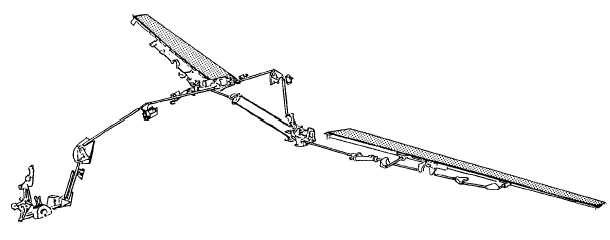FLIGHT CONTROL MECHANISMS
The term flight control refers to the linkage that
connects the control(s) in the cockpit with the flight
control surfaces. There are several types of flight
controls in naval aircraft; some are manually operated
while others are power operated.
Manually operated flight control mechanisms are
further divided into three groups—cable operated,
push-pull tube operated, and torque tube operated.
Some systems may combine two or more of these types.
In the manually operated cable system, cables are
connected from the control in the cockpit to a bell crank
or sector. The bell crank is connected to the control
surface. Movement of the cockpit controls transfers
force through the cable to the bell crank, which moves
the control surface.
In a push-pull tube system, metal push-pull tubes
(or rods) are used as a substitute for the cables (fig.
4-11). Push-pull tubes get their name from the way they
transmit force.
In the torque tube system, metal tubes (rods) with
gears at the ends of the tubes are used. Motion is
transmitted by rotating the tubes and gears.
On all high-performance aircraft, the control
surfaces have great pressure exerted on them. At high
airspeed, it is physically impossible for the pilot to
move
the
controls
manually.
As
a
result,
power-operated control mechanisms are used. In a
power-operated system, a hydraulic actuator (cylinder)
is located within the linkage to assist the pilot in
moving the control surface.
A typical flight control mechanism is shown in
figure 4-12. This is the elevator control of a lightweight
trainer-type aircraft. It consists of a combination of
push-pull tubes and cables.
The control sticks in the system shown in figure
4-12 are connected to the forward sector by push-pull
tubes. The forward sector is connected to the aft (rear )
sector by means of cable assemblies. The aft sector is
connected to the flight control by another push-pull
tube assembly.
LANDING GEAR
Before World War II, aircraft were made with their
main landing gear located behind the center of gravity.
An auxiliary gear under the fuselage nose was added.
This arrangement became known as the tricycle type of
landing gear. Nearly all present-day Navy aircraft are
equipped with tricycle landing gear. The tricycle gear
has the following advantages over older landing gear:
! More stable in motion on the ground
! Maintains the fuselage in a level position
! Increases the pilot's visibility and control
! Makes landing easier, especially in cross winds
4-11
ANf0411
Figure 4-11.—Push-pull tube assembly.
ANf0412
Figure 4-12.—Typical flight control mechanism.





